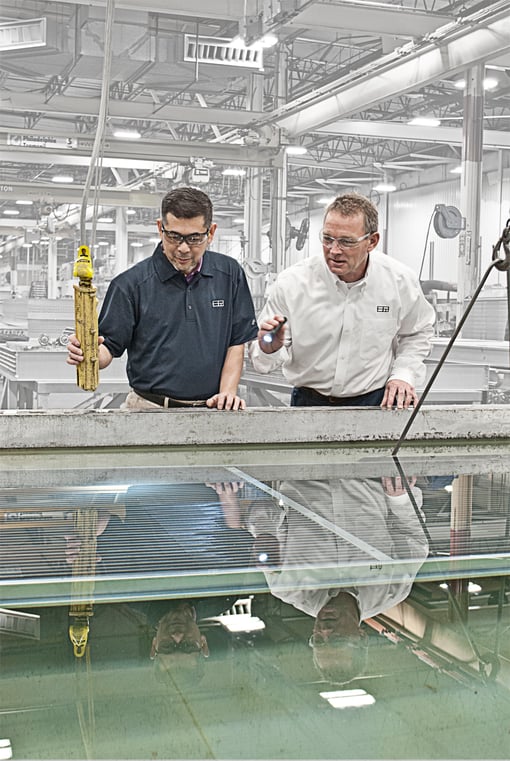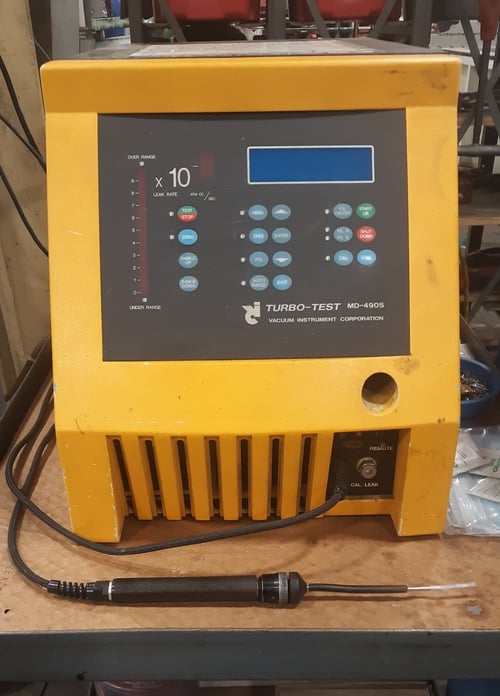Nobody wants leaky coils. You don’t want to waste time and money on buying them and we certainly don’t want to be the one to sell them to you. The goal of this post is to define what a “leak” is from our perspective as a manufacturer and coil supplier. Rather than leaks in the field, this post focuses on what “leak” means in new equipment. To do so, we’ll look at:
- How leaks are quantified
- The testing methods and equipment used to diagnose them
- How SRC's quality program addresses leaks
What is a Coil Leak?
This may seem like a silly question, but it’s true that all leaks are not equal, so the answer isn’t quite that simple. For the purposes of this article, a leak is a void of some kind in a heat exchanger from which the equipment’s working fluid can escape.
It’s important to note that even though your coil may have a void, it might not leak. The molecular size/mass of your working fluid has to be smaller than the void within the coil. R-134a, for example, has a molecular mass of 102 g/mol whereas ammonia’s is only 17 g/mol. So, a pinhole just big enough to allow ammonia to escape would have to be several times larger to constitute a leak in an R-134a system. The videos below show three examples of leaks, ranging from moderate to severe.
How are Coil Leaks Measured?
It’s not so much a question of “is my equipment leaking?” as it is “how much is it leaking?” and “how much is it leaking over time?” Because of that, leaks are measured against a set of standardized leak rate thresholds. Vacuum Instruments Corporation (VCI) has a useful table illustrating different leak rates of popular tracer gases.
Leak rates are specified using the measurement grams per year, which is an extrapolation of atm-cc/sec @ 25°C assuming a constant pressure differential. Testing pressures are typically designed in accordance with a standardization organization such as UL, ASME, and others. Customers can then specify any additional requirements from there.
Typically, Super Radiator’s standard leak tests are conducted using between 250 and 600 PSI of dry nitrogen for one minute, but various other gases and pressures can be used depending on the application’s specified leak testing procedure.
Like what you're reading? Subscribe to our blog and never miss a post!
How are Leaky Coils Diagnosed?
Coils are submerged in water and then pressurized and leaks appear as bubbles under the water’s surface. Tests can range from lower pressure, molecularly larger gases for higher leak rates to higher pressure tests using molecularly smaller gases to determine minute leaks. Two popular leak testing gases which we use regularly are listed below.
- Dry nitrogen - Nitrogen molecules are smaller and used for more “standard” leak testing procedures.
- Helium - Helium testing is a more rigorous test. It has a much smaller molecule and is typically used to diagnose smaller voids.
Additional Leak Testing Equipment
Our test tanks are where we conduct the aforementioned dry nitrogen and helium leak tests. Helium leak testing is a more involved testing method. It requires extra work steps and different personnel skills, and it comes with a higher cost. Depending on the situation, some suppliers may outsource it.

We also have a few helium leak-detecting wand options for customers that request it.
VIC MD-490S: SRC uses the MD-490S portable dry helium leak detector produced by VCI (pictured below). This machine can detect leaks as small as 10(-6).
Agilent Technologies VS Leak Tester: For even smaller leak tests, we have the VS Leak Tester made by Agilent Technologies, which can detect leaks down to 10(-10).

These sophisticated pieces of equipment feature extremely sensitive sniffers that can detect miniscule trace amounts of gases. These tools help us provide our customers with precise leak testing procedures. The sniffer can be dialed in anywhere between 10(-1) and 10(-10), allowing for testing procedures to match the requirement of their specific application.
SRC's Approach to Leaks
It’s important that manufacturers and buyers establish leak testing parameters as a part of the coil’s design. Aligning expectations – especially when it comes to “the ‘L’ word” during the equipment’s design phase is good practice and can spare both parties future headaches.
If you’d like a higher level of rigor beyond our standard leak test, we can augment our procedure to align with your standards. If you’re an OEM who’s having issues with leaking coils, give us a call. We’ll design a custom quality program to make sure your equipment meets your standards.
Don’t get left out in the cold when it comes to heat transfer information. To stay up to date on a variety of topics on the subject, subscribe to The Super Blog, our technical blog, Doctor's Orders, and follow us on LinkedIn, Twitter, and YouTube.




